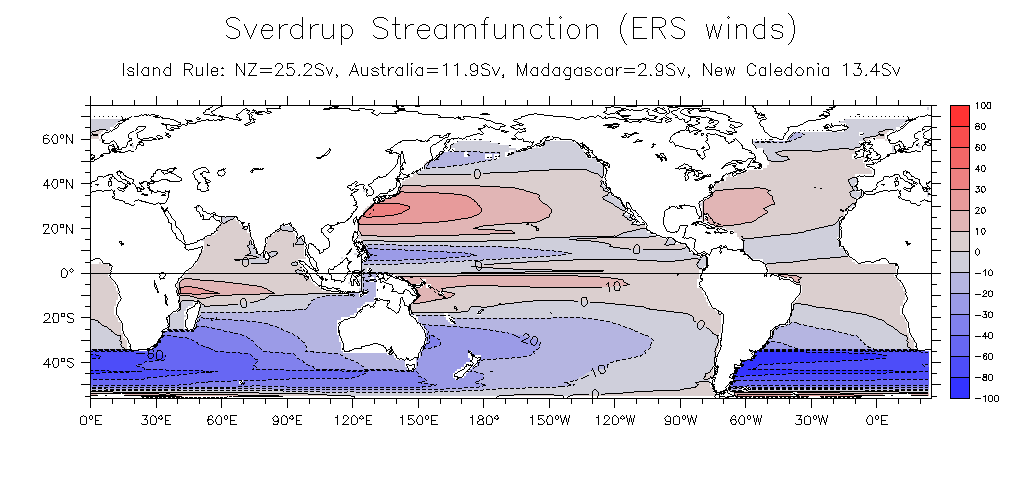Hi Ansley,
thanks for your answer but something doesnt work properly.
my curl_tau is missing over land, so I don't need the land-mask.
if I define PSI like:
LET PSI = IF curl_tau[x=150E:0] THEN (1/(beta*rho_ocean))*( (-1)
*curl_tau[x=150E:0@iin] + curl_tau[x=150E:0@din] )/1E06
the result looks like in the attached image.
The calculation breaks at the boundaries and behind missing values
(islands).
I think @iin doesnt like missing values but I dont know how to
filter them out
so that the integration would be executed only over non-missing
values.
best regards
Theodor
Ansley Manke wrote:
Hi Theodor,
I admit to looking at this just briefly, so I may be missing
something. Is your variable curl_tau missing over land? In that
case, in your definition of psi you should leave off the ELSE 0.
The result will be missing wherever the expresssion curl_tau
[x=160E:0@iin] is false. On this kind of definition there is an
implied "ELSE missing"
Otherwise you need to apply a mask to the data as outlined in this
FAQ about doing integration or averaging over irregular fields by
applying a mask;
http://www.ferret.noaa.gov/Ferret/FAQ/analysis/avg_integ_irreg.html
For your case the mask would be a field which is 1 over water and
missing over land.You could make such a variable from one of the
topography data sets, choosing one which has a resolution similar
to the grid your data is on
yes? use etopo20 yes? let mask = IF rose[d=etopo20,gxy=curl_tau
[d=1]] LT 0 then 1
yes? shade mask ! Look at the plot to check the definition
Dr. Theodor Yemenis wrote:
I am trying to calculate and plot with FERRET the Sverdrup
Streamfunction from the wind stress curl curl_tau
acording to the formel:
Psi = 1/beta Int_xlim(y) ^x curl(tau)dx, xlim (y) is the
longitude of the boundary at each latitude.
I use the following definition (for the pacific ocean):
LET PSI = IF curl_tau[x=160E:0@iin] THEN (1/(beta*rho_ocean))*
( (-1)*curl_tau[x=160E:0@iin] + curl_tau[x=160E:0@din] )/1E06 ELSE 0
fill PSI ; go land
the result is as in the attached GIF-image, but it is not
sutisfing. I have the following problem:
- the islands(Hawaii, New Zeland, ...) and the Continent
(Australia) disdurb the calculation (no streamfunction behind the
land-boarders).
The problem is computing an indefinite integral in an area with
irregular boundaries.
How can I solve this? Can someone help?
best regards
Theodor
--------------------------------------------------------------------
----
--
--------------------------------------
Dr. Theodoros Yemenis
Center for Marine and Atmospheric Research
University of Hamburg
Institute of Oceanography
Bundesstrasse 53
D-20146 Hamburg
Germany
---------------------------------------
phone: +49 40 42838 6104
fax: +49 40 42838 7063
+49 40 36 801 801
email: yemenis@ifm.zmaw.de ---------------------------------------
<Streamfunction.test.gif>
